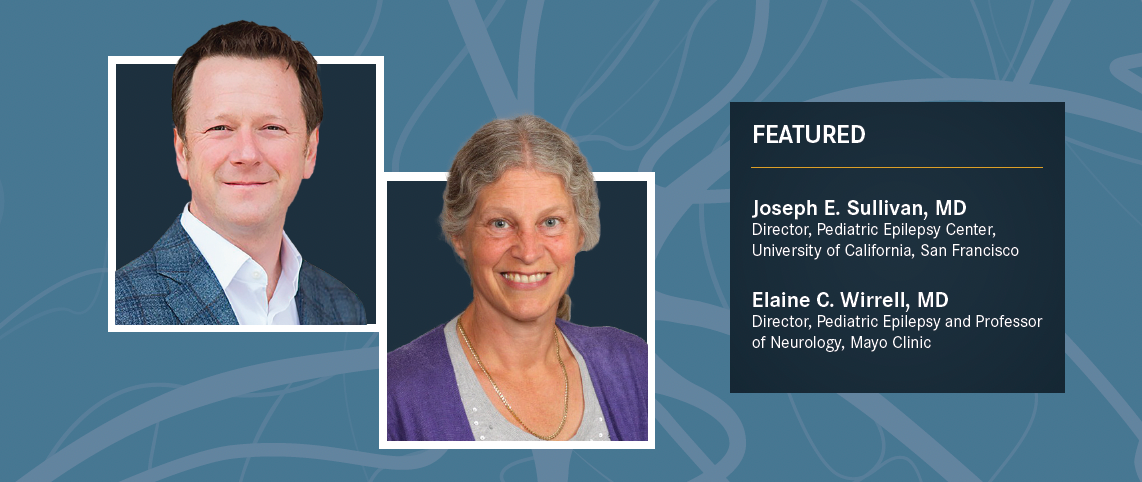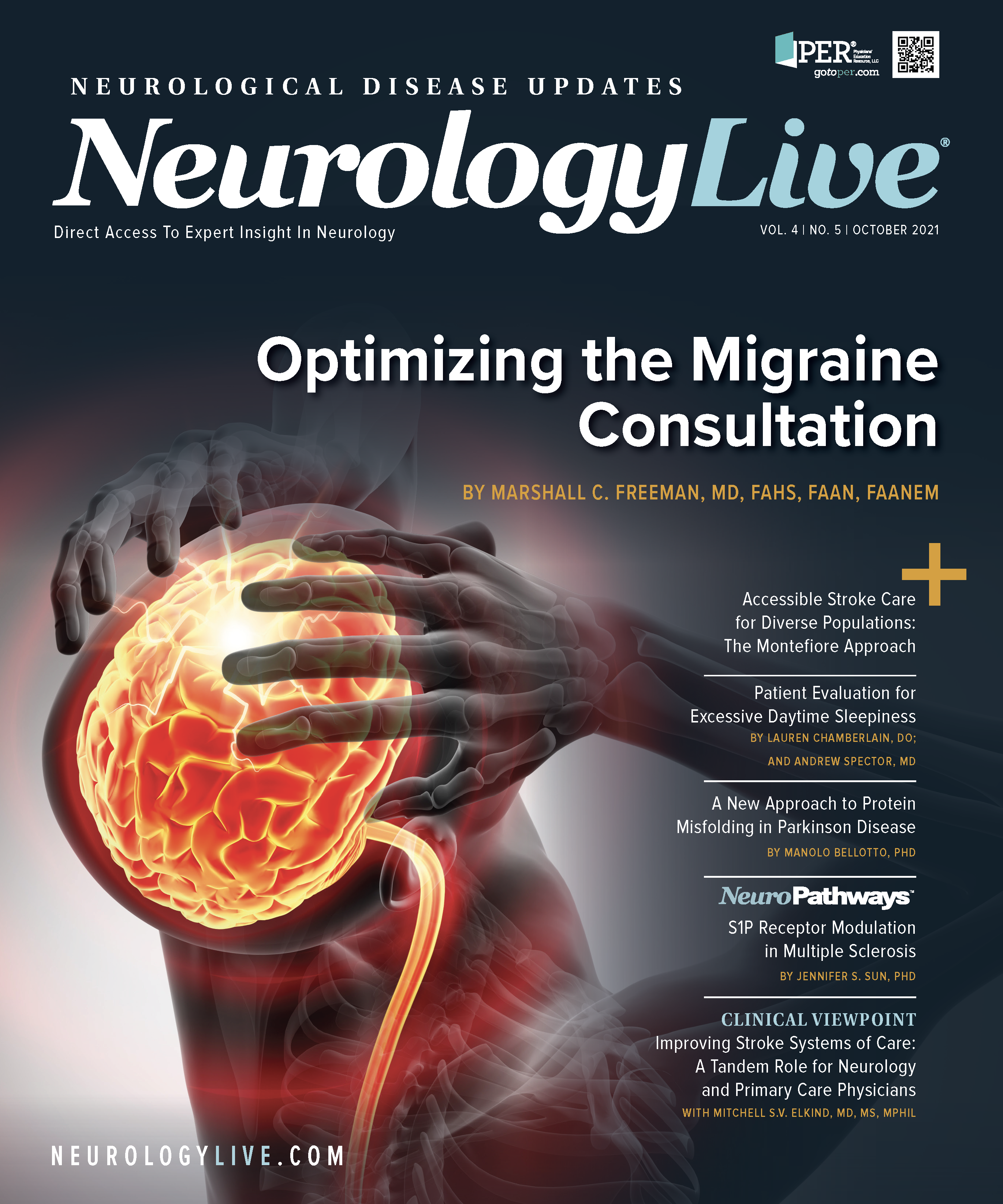Publication
Article
NeurologyLive
The Comprehensive Management of Dravet Syndrome
Author(s):
In a NeurologyLive® Insights series, experts in the diagnosis and treatment of Dravet syndrome discussed the management of the disease and the utilization of approved treatments to improve outcomes in patients.
Left: Joseph E. Sullivan, MD. Right: Elaine C. Wirrell, MD

DRAVET SYNDROME (DS), also known as severe myoclonic epilepsy of infancy, is a rare form of intractable epilepsy that begins in infancy and proceeds with accumulating morbidity that significantly affects individuals throughout life. Approximately 80% of those who receive a diagnosis of DS have an SCN1A mutation, but the presence of a mutation alone is not sufficient for diagnosis, nor does the absence of a mutation exclude one.
Rare, atypical presentation of DS may be associated with other genetic mutations, such as SCN1B, GABRG2, and HCN1. Additionally, seizures lasting more than 10 minutes, those occurring on 1 side of the body, and those triggered by a warm bath in children under 12 months are clues to a DS diagnosis. Although the clinical presentation may be similar, some patients with atypical DS may require alternate paths of treatment.
Early diagnosis of DS is critical to proper treatment and achieving the best outcome. Although patients may be able to reduce seizure severity and number with appropriate therapy, they do not typically reach complete seizure freedom. To understand more about the management of the disease, a recent NeurologyLive® Insights series brought together Joseph E. Sullivan, MD, director of the Pediatric Epilepsy Center, University of California, San Francisco, and Elaine C. Wirrell, MD, director of pediatric epilepsy and professor of neurology, Mayo Clinic. The duo provided perspective on several topics that are vital to the care of patients with the disease.
Early Presentation and Diagnosis of DS
The classic presentation of DS is in an otherwise previously healthy, developmentally normal child. Affected children present first with an often prolonged and often hemiconvulsive seizure, which is frequently associated with fever, often low grade. After age 1, they typically develop other seizures such as myoclonic, absence, and focal-impaired awareness.
“At that point, we start to see the child whose development was normal but then starts to fall off. They’re not gaining those milestones as quickly as we had hoped,” Wirrell said. “That’s the characteristic presenting symptom, and there’s really no other underlying cause that people can find unless you do the genetic testing. The MRIs are normal. Oftentimes the EEGs [electroencephalograms], if you do them remote from seizures, are also normal.”
Febrile seizures are common for these patients and may be red flags for those who have not received a diagnosis. Although DS is a rare disease, it is more common than people may think. Sullivan was part of a study evaluating electronic medical systems and found a new diagnosis for every 15,700 people. Pediatric neurologists will likely encounter this type of patient in practice, Wirrell noted.
Genetic testing has become a crucial component in improving the diagnostic accuracy of DS and other types of epilepsy. Over time, testing has become more accessible and cost-efficient. Multiplex ligation-dependent probe amplification is an assay that determines the copy number of a particular gene and whether that gene has been deleted or duplicated.
Wirrell says that genetic testing should be done as early as possible, especially “in a very young child who has a prolonged febrile seizure, and particularly if it’s a prolonged hemiconvulsive febrile seizure.”
“Those are kids [in whom] I would even think about doing [genetic testing] from the get-go with their first seizure—certainly if there are recurrent prolonged febrile seizures or recurrent hemiconvulsive febrile seizures and particularly if they’ve switched sides,” Wirrell said.
The risk of sudden unexpected death in epilepsy (SUDEP) is higher in those who have DS compared with other epilepsies. Because of this, patients and caregivers alike must create an aggressive rescue plan with their epilepsy specialist to address key signs and symptoms to mitigate the risk of SUDEP. Diazepam (Valtoco; Neurelis) and other benzodiazepines are the go-to rescue medications.
“I know that in my practice, all my patients with Dravet have a seizure rescue plan that’s a little more detailed than maybe [that of] a patient with epilepsy. It even comes as a care coordination note in the electronic medical record that if they hit our [emergency department (ED)], this is what works for them,” Sullivan said. “It’s important to have this individualized approach because we learn, unfortunately, that some of these patients come in within a prolonged seizure. You go through the normal algorithm that [ED] physicians are taught, and it doesn’t work for that patient, but something else does. I certainly think it’s important having that individualized treatment plan.”
Management and Goals of Treatment
In the past few years, 3 new medications have received FDA approval for the treatment of DS, with higher efficacy than that of previous first-line medications used. The first was cannabidiol (CBD; Epidiolex). In June 2018, the FDA greenlit the oral solution for the treatment of seizures associated with DS and Lennox- Gastaut syndrome. It marked the first FDA-approved agent containing a purified drug substance derived from cannabis.
“The goal is really to try to reduce that seizure burden, particularly the prolonged seizures, the ones that are taking the kids into the [ED], into the ICUs [intensive care units]; we want to get rid of those. The convulsive seizures as well,” Sullivan said. “We really want to reduce the seizure frequency because those are the ones that place those patients at highest risk of [SUDEP].”
CBD’s effectiveness was studied in 3 randomized, double-blind, placebo-controlled clinical trials involving 516 patients with Lennox-Gastaut syndrome or DS. CBD, taken along with other medications, was shown to be effective in reducing the frequency of seizures compared with placebo.
Wirrell noted that “it probably does have many mechanisms that we just don’t understand, but as long as we understand the safety profile, I’m OK with that. I’m OK with saying, ‘I don’t know why it works, but it works, and it seems to be safe, so let’s go with it.’”
The most recent drug to enter the market, Zogenix’s fenfluramine (Fintepla), received the go-ahead in June 2020 as an oral solution for patients 2 years and older. The medication was approved with a boxed warning for risk of valvular disease and pulmonary arterial hypertension and is distributed through the Fintepla Risk Evaluation and Mitigation Strategy program.
The robust data from fenfluramine’s clinical program satisfied both Wirrell and Sullivan. They noted the impact fenfluramine had on a proportion of patients who achieved at least 75% seizure reduction. To date, most studies evaluating investigational DS agents had looked at 50% responder rates, whereas fenfluramine demonstrated an extra bit of efficacy.
“I think so much about quality of life and Dravet is related to seizures and breakthrough seizures and prolonged seizures. I think that’s a very negative impact on quality of life for both the kids and the families,” Wirrell said. “I saw these kids actually being able to be kids and being able to get to school more often and participate in family activities more often. Families were getting better sleep. They certainly appeared better rested. So I think [there was] certainly improvement and alertness in the kids with [fewer] seizures. I think we have seen that even more as we’ve been able to address those seizures.”
Building on the momentum of the recent approvals, a handful of other investigational treatments and approaches are in the pipeline. Gene therapy has become an increasingly hot topic throughout neurology and may present opportunities for patients with DS, according to Sullivan. Although encouraged, he noted that he did not anticipate this type of progress 5 years ago.
“It is exciting to think about not only FDA-approved medications to treat seizures but something that could get at the root cause. I think there’s a lot of interest, certainly from us as clinicians and our colleagues, but even more interest on the part of the patient community because this is what they’ve been asking for, for so long,” Sullivan concluded.
View the entire series, “Comprehensive Management of Dravet Syndrome,” here: www.neurologylive.com/dravet-management

Newsletter
Keep your finger on the pulse of neurology—subscribe to NeurologyLive for expert interviews, new data, and breakthrough treatment updates.




